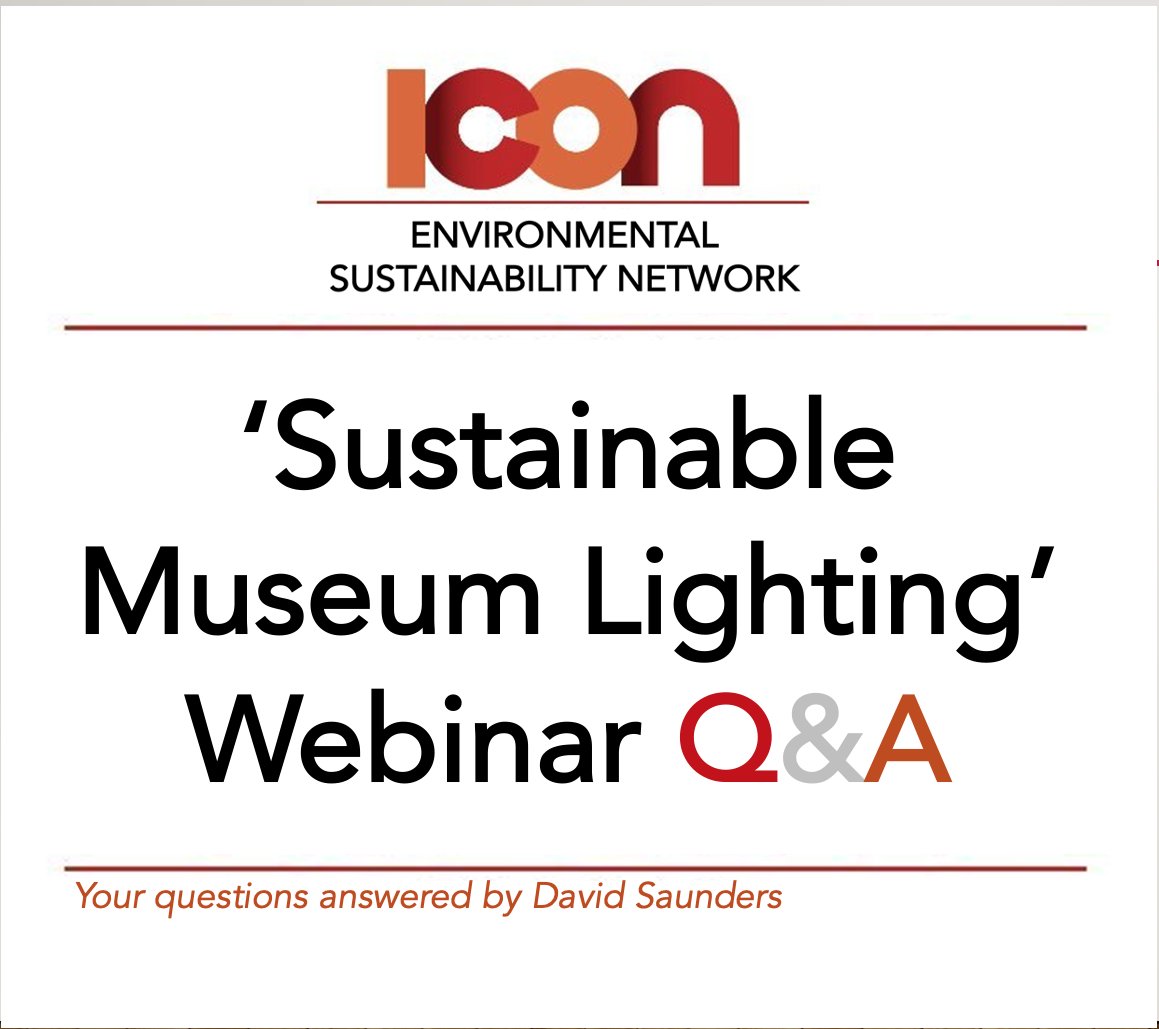Thread: Questions and Answers from our Sustainable Museum Lighting Webinar last Tuesday.
Answers provided by David Saunders (THANK YOU!).
#iconESN #sustainability #museums #environment #conservation #conservator #sustainable #heritage #history #GreenEnergy
Answers provided by David Saunders (THANK YOU!).
#iconESN #sustainability #museums #environment #conservation #conservator #sustainable #heritage #history #GreenEnergy
Q. Is there is a difference in the chemical impact to materials taking the same amount of lux from a LED light and other kinds of lighting technologies (e.g. fluorescent light)?
A. There are some differences between the amount of damage caused by lamps using the same technology that operate at different colour temperatures (on average, lamps with a higher colour temperature are more likely to cause damage)...
...There is some evidence emerging that LED lamps may cause a little less damage than other light sources (incandescent, fluorescent, etc.) with the same colour temperature. It is important to remember however, that individual materials may not follow these general patterns.
Q. In terms of daylight, have you looked at windows have photovoltaics included that produce some electricity?
A. A short answer is no. I am aware that it is gaining increasing popularity in domestic architectural solutions, but one issue with using photovoltaic glass in museums is that we are, potentially, already asking rather a lot from our outer glazing layer: ultraviolet rejection..
... thermal gain reduction (see later answer), good colour properties & perhaps some degree of shading.
I am not sure to what extent the introduction of the photovoltaic layer into our glazing systems would be compatible with these other properties(but I am no architect/engineer)
I am not sure to what extent the introduction of the photovoltaic layer into our glazing systems would be compatible with these other properties(but I am no architect/engineer)
Q. We often have to run new wiring for lighting control, it can be very expensive and some fittings are only compatible with certain system. Do you know whether the industrymight be heading towards wire-less so that less impact on existing fabric and possibly more sustainable?
A. Yes, there is a move towards wireless control, e.g. through Bluetooth, but I am not sure how fast this will extend widely into museum settings. If wired lighting control is anything to go by, there is also no guarantee that future systems will all use the same protocols...
... It is worth bearing in mind that, while wireless control might help sustain the historic fabric of a building, it may consume considerable energy and its operation may be complex and require specific expertise not always present in smaller organisations.
Q. LEDs seem to produce more glare than other lighting sources, probably as the light source is right at the front of the fixture. Museum lighting designers must take this into account, especially when designing in-case lighting, making sure the LED itself is blocked from view.
A. I agree that it is more a function of luminaire design than an intrinsic issue with LEDs. Their very small size makes it possible to place them more-or-less anywhere, so good lamp positioning and lighting design are – as you say – crucial.
Q. How expensive is electro chromic shading? I presume this shades the windows according to the lux levels?
A. The cost of system will depend on the type used. Electrochromic film (that I showed) is at the less expensive end of the market, but so-called smart glass is much more costly (I am afraid I do not have figures).
These are electrochromic not photochromic products, so ...
These are electrochromic not photochromic products, so ...
... they don't react to light levels but to the application of an electric current. If a photocell is used to generate that current, they will respond to light, but the film or glass can also be darkened in response to other events.
Q. Is there any conservation issue related to the use of ‘switching of lights responding to the presence of visitors’? Any negative effects on the objects?
A. I cannot think of any negative effects on the object of switching off the lights in absence of visitors: this reduces energy consumption and contributes to extending the lifetime of objects that are vulnerable to light damage...
... If a system based on sensing visitors is used, some care is needed to make sure that it does not switch the lights off just because the visitor is not moving.
Q. With daylight lighting, one of the concerns has been the heat produced through solar gain and the cost of cooling because of it. Has there been much done on the costing for this?
A. Heat gain from daylight can be an issue – and another reason why some museums simply opt for its exclusion. But heat rejecting glazing (sometimes called low-E glass) is now widespread and can contribute both to rejecting solar gain and heat retention by a building.
Q. Any notion of conflict free used material to be included in sustainability societal goals?
A. A number of lighting suppliers already have statements on their websites regarding their due diligence processes to avoid the use of conflict minerals. These are generally regarded as the metal or ores of tantalum, tungsten, tin and gold (sometimes called 3TG)...
... In the US, outlawing conflict minerals forms a part of wider legislation enacted in 2010 ( https://www.congress.gov/111/plaws/publ203/PLAW-111publ203.pdf).
The EU has also long recommended due diligence on sourcing these materials, with new regulations coming into force on 1 January 2021 ( https://eur-lex.europa.eu/legal-content/EN/LSU/?uri=CELEX:32017R0821&qid=1542740800246).
The EU has also long recommended due diligence on sourcing these materials, with new regulations coming into force on 1 January 2021 ( https://eur-lex.europa.eu/legal-content/EN/LSU/?uri=CELEX:32017R0821&qid=1542740800246).

 Read on Twitter
Read on Twitter


